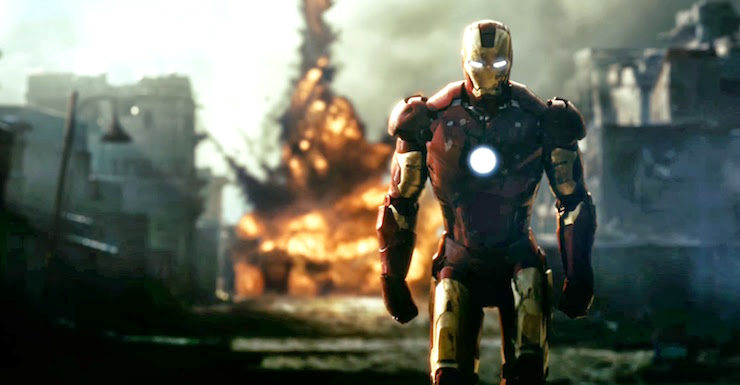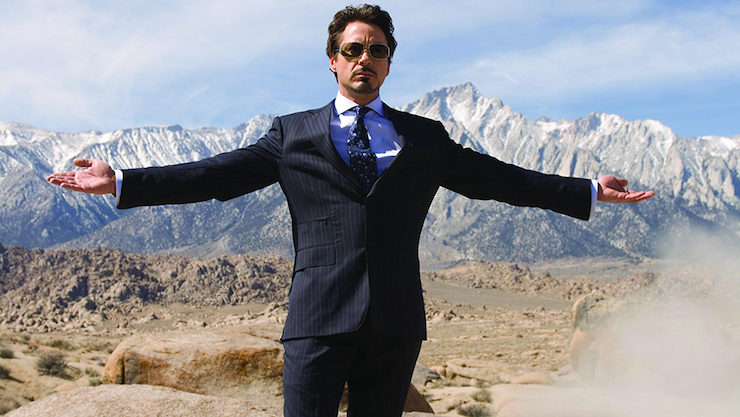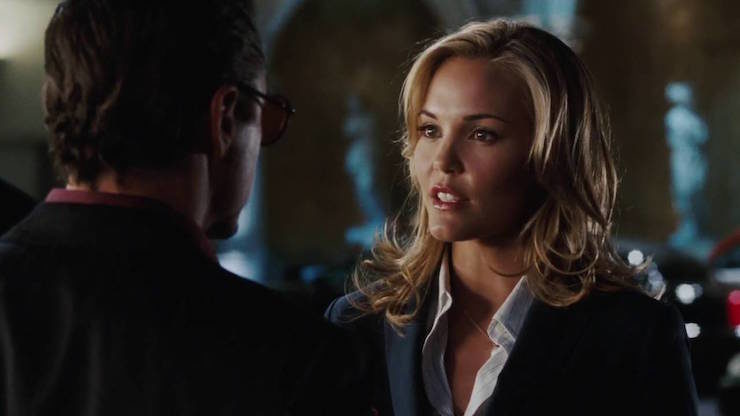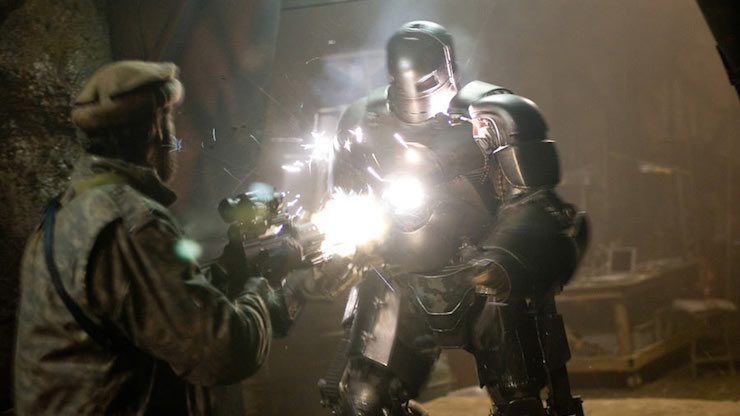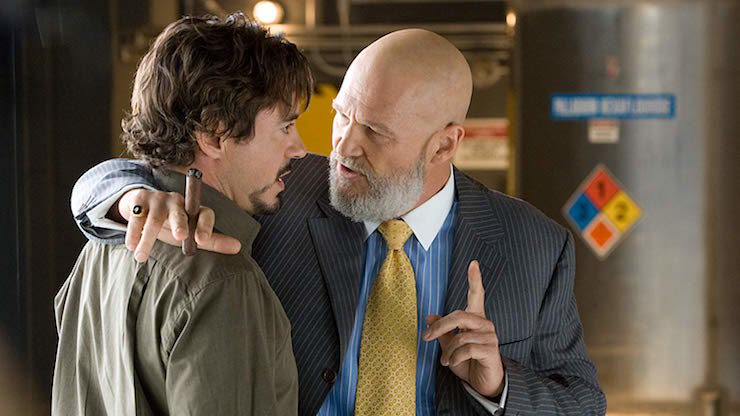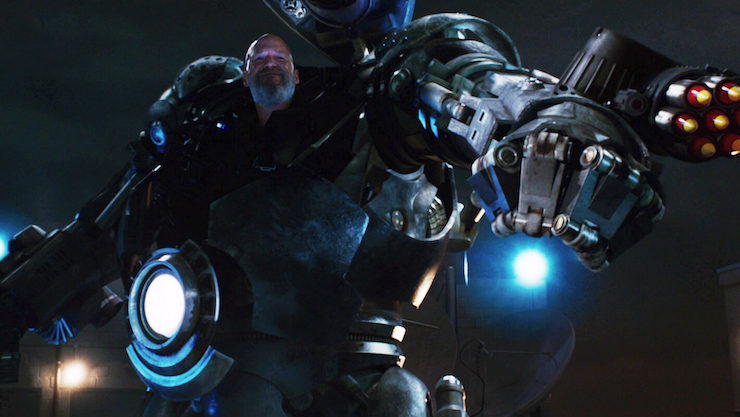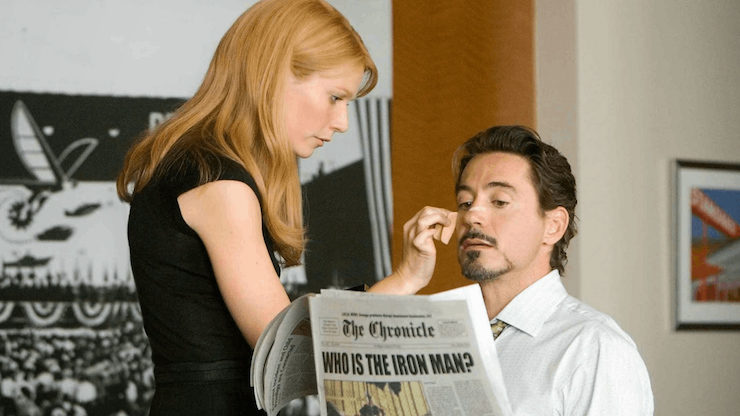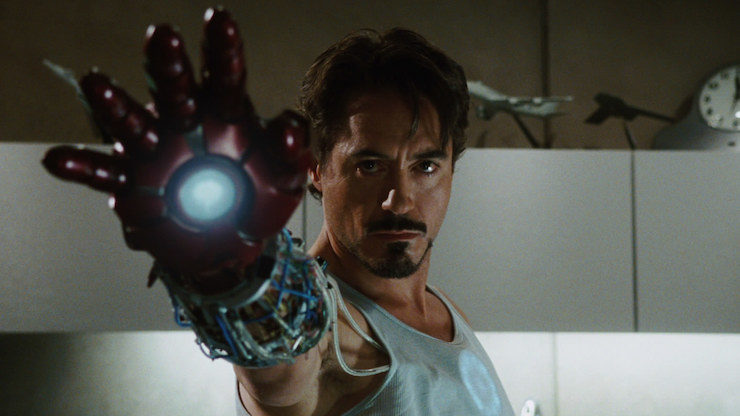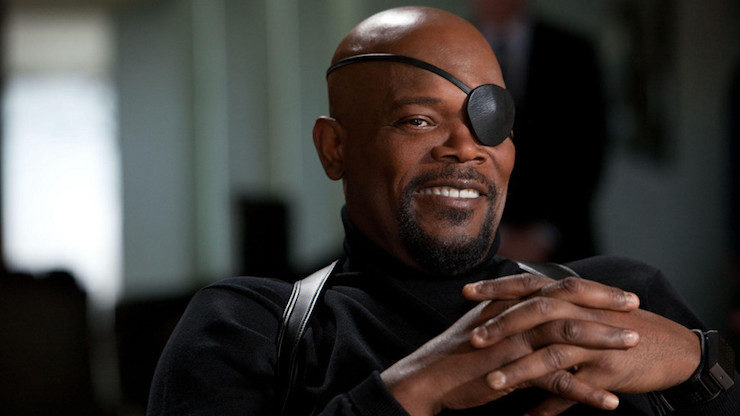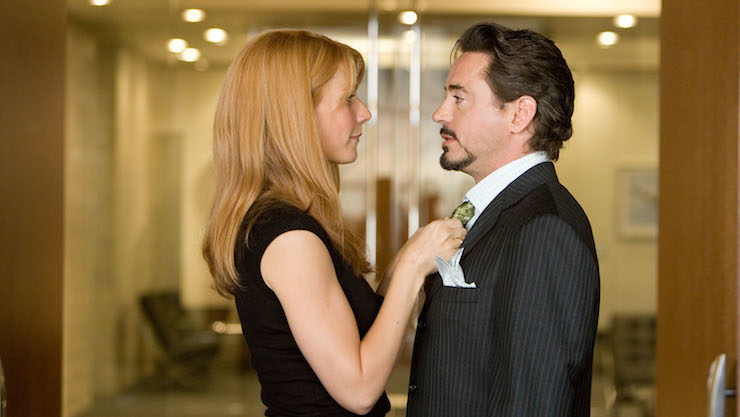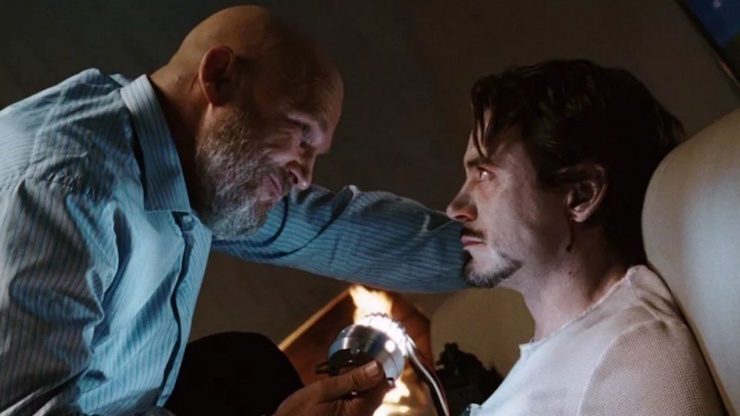Iron Man was part of the huge first wave of superheroes co-created by Stan Lee in the early 1960s, in collaboration with a variety of artists, mainly Jack Kirby and Steve Ditko, but also Bill Everett, Larry Lieber, and Don Heck.
While never a headliner in the Marvel Universe, ol’ ShellHead was always a major player at the very least. He was a founding member of the Avengers, a presence in a lot of stories as the inventor (or at least the owner of the company that invented) much of the Marvel Universe’s fancy tech, the financial backing of the Avengers, and the centerpiece of several major events in the comics, from the Kree-Skrull War to the Armor Wars to Operation: Galactic Storm to Civil War.
Since the movie rights to most of Marvel’s biggest names—Spider-Man, the X-Men, Daredevil, and the Fantastic Four—were already gobbled up by other studios, Marvel decided to focus their nascent Marvel Studios endeavor on the Avengers characters, starting with Iron Man.
Originally imagined as a latter-day Howard Hughes, Tony Stark is a brilliant engineer, a good-looking man who is something of a womanizer, and a rich, successful industrialist. I want to say he’s the type of person you don’t see in real life, but there’s Hughes. Still, not a lot of people combine all three of those things.
Like most of Marvel’s early heroes, Iron Man’s origin was very much a product of its time, as Stark’s primary method of making a living was to build weapons for the United States military. While in southeast Asia checking out his weapons, he’s taken hostage by an Asian warlord and told to construct a weapon for him. Instead, he secretly builds a suit of armor, which also serves as a glorified pacemaker, as shrapnel from an explosion is nearing his heart.
Unlike several other contemporary heroes, Iron Man’s origin has generally been easy to update, mainly because there’s always been somewhere where we’ve got troops. In 2008, it was Afghanistan, and Stark’s odyssey of armor-creation was easy enough to relocate there without changing much except the nationality of his captors. (His comics origin was officially retconned to the Gulf War at one point, and more recently to the War on Terror, like the movie.)
Buy the Book
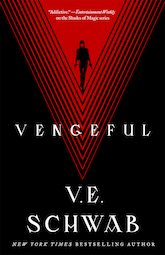

Vengeful
An Iron Man movie was in development throughout the latter portion of the 20th century, just like every other Marvel character after Stan Lee moved out to California to drum up movie deals. Lee himself co-wrote a treatment for an IM film with Jeff Vintar. Among the names attached to direct over the years: Stuart Gordon, Quentin Tarantino (really!), Joss Whedon, and Nick Cassavetes. Both Nicolas Cage and Tom Cruise had expressed interest in playing the title role, and other scripts were done by Jeffrey Caine, Tim McCanlies, and Alfred Gough & Miles Millar, among others.
Finally, in 2005, Marvel decided to start from scratch and release Iron Man through their own studio arm. They saw how successful Dark Horse had been producing their own films, and also realized how much more money they’d have made off of the Spider–Man and X-Men movies if they’d produced them themselves instead of selling the rights to other studios.
Jon Favreau, who’d wanted to work with Marvel again after Daredevil, was hired to direct, and he also co-starred as Happy Hogan. Favreau combined two scripts, and provided a movie that combined the character’s origin in Tales of Suspense #39 by Lee, Lieber, and Heck with Denny O’Neil’s ongoing 1980s arc in Iron Man that chronicled Obadiah Stane’s slow takeover of Stark International and their eventual confrontation in Iron Man #200, Stane now in armor as the Iron Monger.
The success of the Spider- and X-movies without any A-list stars helped Favreau convince Marvel not to go for a huge name to star. In fact, his original thought was to go with an unknown, but he went with Robert Downey Jr. in part because Downey Jr.’s own life’s ups and downs, including all his personal travails being in the public eye, mirror Stark’s in the movie.
At this point, the notion of an interconnected universe was in its formative stages, but producer Kevin Feige did, at least, intend for the characters that Marvel Studios had controlling interest of to all exist in the same continuum. To that end, Downey Jr. made a cameo in The Incredible Hulk between this movie and its 2010 sequel.
The cast includes several folks who would recur throughout what would eventually be the Marvel Cinematic Universe. Besides Downey Jr. as Stark (who has, as of this writing, appeared in nine films, and is at least mentioned in three others) and Favreau as Hogan (four films), there’s Gwyneth Paltrow as Pepper Potts (six films), Clark Gregg as Agent Phil Coulson of S.H.I.E.L.D. (four films, several shorts, and the star of Marvel’s Agents of S.H.I.E.L.D. for five seasons), Terence Howard as Jim Rhodes (the character appears in five subsequent films played by Don Cheadle), Paul Bettany as the voice of J.A.R.V.I.S. (five films, plus three more as the Vision, for which the J.A.R.V.I.S. AI was a template), and, of course, Samuel L. Jackson’s cameo in the post-credits scene as Nick Fury, the director of S.H.I.E.L.D., the first of ten appearances (so far) by Jackson in either a film or a TV episode in the MCU. All the above characters are scheduled for more appearances, too….
“You’re a man who has everything and nothing”
Iron Man
Written by Mark Fergus & Hawk Ostby and Art Marcum & Matt Holloway
Directed by Jon Favreau
Produced by Avi Arad and Kevin Feige
Original release date: May 2, 2008
In Afghanistan, Tony Stark is being ferried in a Humvee by three airmen. They’re nervous around him at first, but he himself breaks the ice and they’re asking him questions about his sex life and asking for selfies to be taken with him.
Suddenly, they’re under attack. All three escorts are killed, and Stark is caught in an explosion. He wakes up to find himself being filmed with people around him talking in a foreign tongue.
We then zip back 36 hours to Las Vegas, where Stark is receiving an award. A video presentation provides exposition on his history: his father, Howard Stark, worked on the Manhattan Project; Tony was a child prodigy, graduating with honors from MIT; a car accident claimed Howard and his wife Maria when Tony was a teen; Obadiah Stane, Howard’s business partner, ran the business until Tony was of age; now Stark and Stane run the company together.
Stark is busy gambling and therefore misses getting the award, presented by his childhood friend Colonel James Rhodes and accepted by Stane. Stark is ambushed by Christine Everhart of Vanity Fair about his work as a weapons manufacturer. Stark defends his choices, and winds up convincing Everhart to fly back to Malibu with him and spend the night.
The next morning, Stark’s assistant Pepper Potts gives Everhart her (freshly dry-cleaned) clothes and Stark’s good wishes, as well as a healthy dose of snark. Stark himself is downstairs working on one of his many vintage cars. He shows up three hours late for his flight to Afghanistan with Rhodes, where he is to demonstrate Stark Industries’ new Jericho missile system.
The demo is a huge success—and then, on the way back to the airfield, they’re ambushed. Before he falls into a coma, Stark notices that they’ve been attacked by Stark weapons.
Stark wakes up to find another scientist who is prisoner of the terrorists who attacked the convoy: Yinsen, who was able to keep the teeny-tiny bits of shrapnel from occluding Stark’s heart by use of an electromagnet hooked up to a car battery. The terrorists, who call themselves “the Ten Rings,” force Stark to build one of his Jericho missiles for them. Stark reluctantly agrees—and then proceeds to do his own thing. With Yinsen’s help, he builds a miniature ARC reactor, which more efficiently keeps his heart safe. Then, under the cover of building a missile, he instead constructs a suit of armor that will be powered by the reactor in his chest.
Yinsen told Stark at one point that he will see his family when he leaves this place. Only when he sacrifices his life to buy Stark time to power up the armor does Stark realize that his family is dead—he always intended to die to escape imprisonment. Stark thanks him for saving his life and Yinsen’s dying words are to urge him not to waste that life.
The armored Stark makes short work of the Ten Rings terrorists, and tries to fly away after destroying their weapons depot. However, the jet boots don’t quite work as he’d hoped, and he crash-lands. However, the conflagration got the attention of the U.S. military, and he’s rescued by a team led by Rhodes.
Stark returns to the U.S. battered, bruised, and furious that his weapons have wound up in terrorist hands. Instead of going to a hospital, he goes to Burger King, as he’s jonesing for a cheeseburger, and then calls a press conference and announces that Stark is getting out of the weapons business—a revelation that shocks both Stane and Rhodes.
Stane does damage control, first with the press, then with the Board of Directors, and also suggests that Stark lay low to recover and give him a chance to do that damage control. Stark spends his time in the basement of his house working on a better suit of armor, starting with a better miniature ARC reactor. (He tells Potts to throw the one he made in Afghanistan away, but she instead puts it in lucite with a plaque that reads, “PROOF THAT TONY STARK HAS A HEART.”)
In Afghanistan, Raza, the leader of the Ten Rings group that kidnapped Stark, manages to reconstruct the armor Stark built. Meanwhile, Stane reluctantly informs Stark that the Board of Directors has voted to sanction him.
After several weeks of testing the new armor, Stark goes off to attend a party, saying hi to Hugh Hefner (who looks just like Stan Lee), and seeing Potts in a beautiful dress that he apparently bought for her. (Meaning she bought it for herself with his money.) He dances with her, which she finds awkward, because he’s her boss. He offers to fire her, and she points out rightly that he wouldn’t last five minutes without her. They go to the roof to get some air and they almost kiss before they remember that it would be inappropriate. Stark offers to get her a drink, and while he’s waiting for it, Everhart confronts him with pictures of terrorist cells in the Middle East that have Stark weapons. Stark is livid, and confronts Stane, who admits that he was the one who sanctioned him.
Stark puts on the armor and flies to Afghanistan to destroy the cache of Stark weapons. He then gets into it with two Air Force planes (and initially lies to Rhodes about where he is when Rhodes suspects him). One of the planes is damaged, the pilot bailing out, but his chute won’t deploy. Stark risks his life to save the pilot’s life, then flies off.
After returning home, Stark sends Potts to copy files off of the Stark server, and one of the things she finds is the video that was recorded right after Stark was kidnapped. The Ten Rings attacked the convoy with orders to kill everyone, not knowing that Stark was one of the targets. They kidnapped him and used him rather than kill him as Stane instructed. But Stane is the one who ordered the hit.
For his part, Stane—who has already gone to Afghanistan and killed Raza and his people to tie up loose ends (pointing out to Raza that if he’d killed Stark like he was supposed to, this would never have happened)—visits Potts, hoping to grill her for information about Stark. Only after she leaves does he realize that she pulled files off the server.
Agent Phil Coulson of the Strategic Homeland Intervention, Enforcement, and Logistics Division has been trying to debrief Stark since he got back from Afghanistan. With Stane now after her, Potts confides in Coulson, who summons more agents to protect her.
Stane, however, already got to Stark, having used a neural paralyzer to immobilize him and then remove the reactor from his chest, condemning him to death. Stane has been building his own armor since killing Raza, but the other scientists in his employ have been unable to miniaturize the reactor. (Stane’s furious complaint that Stark built one in a cave with scraps is met with a very meek reminder that they are none of them Tony Stark.) So Stane steals Stark’s glorified pacemaker.
While Stark is able to stumble downstairs to the basement to put in the old reactor that Potts had made into an award, Potts and Coulson don’t arrive at Stark Industries in time—Stane has put on his own armor (which is way bigger than Stark’s), and he pounds the crap out of the S.H.I.E.L.D. agents. Before he can kill Potts, Stark shows up in his armor. While he’s no match for Stane directly, especially with the lesser reactor powering his armor, he is able to occupy him long enough for Potts to overload the large-scale reactor that powers Stark Industries with Stane on top of it.
Stane and Stark’s fight was public, and the media refers to the red-and-gold-armored person who attacked the depot and fought the bigger armored person as “Iron Man.” S.H.I.E.L.D. creates a cover story for both Stark and Stane, and also say that Iron Man is Stark’s bodyguard. However instead of confirming the cover story, Stark admits that he’s Iron Man at the press conference.
After the credits, Stark arrives home to find Nick Fury, the director of S.H.I.E.L.D., already there, telling him that he’s part of a much larger universe now (ahem), and also mentions something called the Avengers Initiative.
“I’m just not the hero type”
Back in 2008, I saw Iron Man at the late, lamented Ziegfeld Theatre, and the usher had to tell everyone who came in, “Stay all the way through all the credits. Trust me.” On the one hand, that seems quaint ten years on—on the other, there are still people who leave Marvel movies before the credits are done, so there you go. However, I just love that Marvel Studios started doing the whole post-credits thing, as it’s a joy. They haven’t always landed (I’m looking at you, Guardians of the Galaxy), but they’re often a lovely Easter egg to the hardcore fans.
More to the point, though, they get people to sit through the credits. Which you should do anyhow, these people worked hard on this movie, and they deserve it. I despise the current trend in television to shrink closing credits to nothing while ads run, because the whole point of credits is to be read. These are people who did a good job and helped make the movie happen, dagnabbit!
Anyhow, ten years later, nobody has to remind anyone to sit through to the end of a Marvel movie, but it was a big deal here. Up until Stark walked in to find Fury in his house, this was Yet Another Standalone Superhero Movie, just like most of the others I’ve done in this rewatch to date. And then Fury shows up and says he’s part of a bigger universe (Marvel has always referred to their milieu of superheroes as “the Marvel universe”) and he drops the word “Avengers” and every fanboy heart goes squee because right there we’ve been promised the one thing that only one feature-length adaptation (the first two Incredible Hulk TV movies of the late 1980s) had done.
Pretty much every superhero comic book line has been interconnected, from World War II (when you had superheroes teaming up to fight the Axis powers) forward. Mostly this interconnectedness was seen in team books—the Justice Society of America in the 1940s, the Justice League of America and the Avengers in the 1960s, and so on—plus in team-up books (Marvel Team-Up, The Brave and the Bold).
But the screen adaptations never followed suit, mostly because the rights to the characters always wound up with different studios. With Marvel Studios controlling this set of characters themselves, Kevin Feige was able to finally re-create that one aspect of superhero comics that had long been missing from their screen adaptations.
All that from one post-credits scene, but that’s the least of why Iron Man is an excellent film. It’s all well and good to want to create a coherent universe, but that’s less relevant than actually making a good movie (something that others who have tried to re-create the MCU’s success have sometimes forgotten; I’m looking at you, Tom Cruise’s The Mummy).
Luckily, Iron Man is a very good movie, which is one of the main reasons why the MCU has been a success for a decade now. It starts off brilliantly, establishing Stark’s character quickly and efficiently as he sits in a Humvee holding his drink steady as it bounces through the desert and chatting with his escorts. It’s to the credit of Favreau and the screenwriters that this scene is so brilliantly effective, as we only have a few minutes to get to know these characters before they’re shot at. They don’t just redshirt the three airmen, they’re three people you actually care about, so it matters (to us and to Stark) when we see them die.
Looking back ten years on, you can see the “Marvel formula” for an origin movie: flawed person has an eye-opening experience that leads to that person being put in a position to become a hero. Sometimes the heroic instinct is already there, but they’re prevented from fulfilling it, and sometimes they need to go on the journey to become a hero. Iron Man is assuredly the latter, as the Stark we meet at the top of the film is a charming asshole. It takes the trauma of being kidnapped, and of seeing his weapons being used by terrorists, to wake him up and make him turn himself into a superhero.
What’s especially fascinating about the movie is that it departs from the comics in several distinctive ways, the biggest being Robert Downey Jr.’s performance. His wiseass portrayal of Stark has become the cornerstone of the MCU, so it’s easy to forget that it bears only a passing resemblance to the personality that Stark has had in the comics since 1963. But then, Stark has always been very much a product of the 1960s, the suave, cool, debonair jet-setter that was a particularly strong archetype in that decade. Downey Jr.’s portrayal is more appropriate for the 2000s, and he absolutely makes it work.
Plus, like any good adaptation, the essence of Stark remains the same: he’s a genius industrialist with several character flaws who has to ante up and be a hero. It was less of a journey in Tales of Suspense #39, but that was also the first of an ongoing monthly series of stories. Iron Man needed to tell a story in and of itself, and a big part of what makes the movie compelling is Stark’s journey from uncaring asshole who gives his major award away to an actor in a Caesar costume, who plays dice instead of accepting that award, who sleeps with a reporter trying to do a piece on him, who brings a drinks cabinet along with his crates of weapons to a demo—into a hero, into someone who will break a no-fly zone to save kids from being killed by terrorists wielding weapons he designed.
He’s also surrounded by a superb cast. Gwyneth Paltrow is radiant as Pepper Potts, Stark’s personal assistant and something vaguely resembling a love interest. It’s actually played really well, as it ends, not with the kiss and declaration of love that movies have trained us to expect, but instead with Potts tartly reminding Stark that he left her on a rooftop waiting for a drink that never came because he got sidetracked by Everhart showing him pictures of terrorists using his weapons. The chemistry between Downey Jr. and Paltrow is superb—and will remain so through several movies—but the relationship is also fraught, as the journey Stark goes on here is not one he’s even remotely finished going on.
One of the knocks on the MCU has been the comparative weakness of the villains. Usually the exceptions cited are Loki and, more recently, the Vulture and Killmonger, but nobody ever mentions Jeff Bridges as Stane, and I can’t for the life of me understand why, as he’s absolutely fantastic. The revelation that he’s the bad guy is less effective if you know the comics—Stane was an unrepentant bad guy in the comics, a rival to Stark from the moment he first appeared in Iron Man #163, and arguably the villain who hurt Stark the most, as he assisted his descent into alcoholism and took his company away from him. Here, Stane is a trusted ally who turns out to be a snake in the grass (a theme the MCU will come back to more than once), and Bridges is magnificent in the role. He brings his relaxed charm to the role, looking dapper in his brightly colored suits and his pinky ring and his always putting an arm around Stark, and it all hides a ruthless streak that we really don’t see until he kills Raza. Even then, the avuncular mien that lulls you into a false sense of security stays up almost the entire time—the only time it doesn’t is when he rips the scientist a new one for not being able to miniaturize the ARC reactor.
And then we have Clark Gregg. Originally a one-off walk-on role to establish S.H.I.E.L.D.’s existence, Gregg’s professional deadpan makes Coulson into a hugely compelling character. His effortless competence in this film would lead to him becoming the glue that holds the first set of MCU films together, and later starring in his own TV show.
One shouldn’t forget Shaun Toub. Yinsen is an understated but important role in the creation of Iron Man. His arc in this movie is the same as the character’s in the comics, and Toub plays it beautifully. He knows his fate, and he knows his only chance at redemption is to help Stark. He helps create a hero, and that’s his legacy, even if it’s one that only Stark knows about. And Paul Bettany is a delight as J.A.R.V.I.S., the AI that runs Stark’s house and later the Iron Man armor. (The TV series Agent Carter will later establish Edwin Jarvis as Howard Stark’s butler, and one suspects the naming of the AI after him is due to fond memories of Jarvis that Tony has from when he was a kid.)
The other performances are a bit more hit-and-miss. Terence Howard creates very little impression as Rhodes—the re-casting with Don Cheadle will prove to be trading up, and besides, it freed Howard to star in Empire, which is a much better role for him—Faran Tahir is disappointing as Raza, and Favreau is surprisingly nondescript as Happy Hogan (though future films will do better with him).
Even if this wasn’t the vanguard of the most successful series of movies in the history of the universe, this would be a very good superhero movie. Stark’s heroic journey—which will have many many many bumps in the road—will continue to be a theme throughout the entire MCU (two more of his own movies, as well as all the Avengers movies and one each of the Captain America and Spider-Man films), and the start of it is a classic, with a great villain, a strong plot, and a climax that nicely allows Stark and Potts to collaborate.
Next week, we look at what was, in essence, a mulligan on Ang Lee, as well as the first crossover since (appropriately) The Trial of the Incredible Hulk, as we look at Edward Norton’s one-movie tenure as The Incredible Hulk.
Keith R.A. DeCandido has never actually written Iron Man, though he’s written Spider-Man, the Hulk, the original X-Men, the Silver Surfer, Thor, Sif, and the Warriors Three. However, he did edit a series of Marvel novels in the 1990s that included two Iron Man novels by Greg Cox, a Spider-Man/Iron Man team-up novel by Danny Fingeroth, Eric Fein, & Pierce Askegren, an Avengers novel by Askegren (which included ol’ ShellHead), and an Avengers/X-Men trilogy by Cox (ditto).










